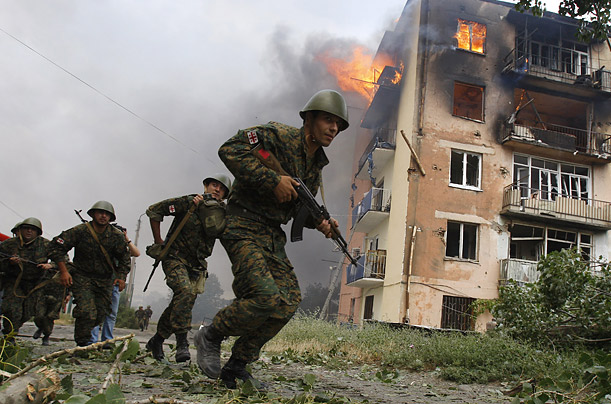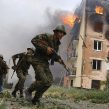
The Russia-Georgia Conflict: Analyzed by the Center of Analysis of Strategies and Technologies in Moscow: Part One
Publication: Eurasia Daily Monitor Volume: 7 Issue: 15
By:

The Center of Analysis of Strategies and Technologies (CAST) in Moscow has published a collection of essays devoted to the Russia-Georgia conflict in August 2008 (Mikhail Barabanov, Anton Lavrov, Viacheslav Tseluiko, Tanki augusta: Sbornik statei Moscow: Tsentr Analiza Strategii i tekhnologii, 2009., 144 pp., PDF: https://www.cast.ru/comments/?id=351 ). In a time when the discussion of fourth generation warfare and counter-insurgency seems to be the sole preoccupation of Western militaries, the title of this work appears quaint and anachronistic. Do the Russians not understand that the era of armored warfare is over and the tank has no future on the battlefield? Upon reading this book, however, the authors’ point becomes quite clear. Both the Georgian and Russian armies had armor as their basic combat power. This was still warfare of the industrial era, apart from the presence of UAV’s. Neither side could afford a protracted struggle. Georgia gambled on a Blitzkrieg of South Ossetia, and the Russian government understood the risks of a protracted war that threatened to bring in foreign military intervention. Both sides were driven by political objectives. The government wanted to use military means to take the South Ossetian capital Tskhinvali, to undermine its claim of independence and thereby strengthen Georgia’s sovereignty. Russia intervened to punish the Saakashvili government and undermine its legitimacy at home and abroad. The three authors from CAST in Moscow bring their considerable expertise to the analysis of the background, conduct, and consequences of the Five-Day Russian-Georgian War of August 2008.
Viacheslav Tseluiko, an analyst from Kharkov, Ukraine, addresses Georgian military reform under Saakashvili, emphasizing the decision to follow a Western organizational model and procure arms and equipment from abroad. The weapons transfers listed in the book, accelerated after Saakashvili became president, involved deliveries of Soviet models of armed vehicles, artillery, radar and electronic warfare systems from Ukraine, the Czech Republic, Bulgaria, Bosnia-Herzegovina, and Uzbekistan. Other states providing arms included Israel, Turkey, Greece, and the United States. Israel supplied advanced UAV technology and air defense systems. Turkey delivered light armored vehicles. This choice of arms and organization is significant not only for the political direction of Georgian policy, but also because the Russian armed forces faced a Western-style army for the first time, and the authors emphasize the fact that this is of considerable importance in assessing the course and outcome of the war. On the basis of a review of Georgian national security statements, including the National Security Concept, Threat Assessment Document, National Military Strategy, National Defense Review, and Ministry of Defense Vision Statement, he emphasizes that the central purpose of this rearmament, and military reforms under Saakashvili, was to restore the territorial integrity of Georgia. While this had been a goal of the Georgian state since the fighting that led to the separation of Abkhazia and South Ossetia, Saakashvili was eager to achieve this goal by military means as expeditiously as possible. Saakashvili ordered the attack even though the best-trained unit in the Georgian army, the 1st Infantry Brigade, had deployed to Iraq in support of counter-insurgency operations. Thus, Tseluiko presents the attack upon South Ossetia as a coup de main, a rapid attempt to occupy Tskhinvali and isolate the theater before meaningful counteraction could be initiated by Russia, as the protector of South Ossetia. This strategic choice proved to be both a military and political disaster for Georgia and its government. The Russian response, as Tseluiko makes clear, was well planned and timely. The speed and power of the Russian response underscored what were basic contradictions and failures in Georgia’s military preparations. These included doctrinal contradictions, unstable planning, weak training of cadres, frequent purges of command personnel on political grounds, and the associated unpreparedness of senior commanders to conduct operations. The Georgian forces had devoted considerable training time to counter-insurgency operations, but the Georgian government asked its armed forces to execute a rapid and decisive combined arms operation. In the face of the decisive Russian counter-attack, the engaged forces began a withdrawal that quickly turned into a rout, and the national system of total mobilization—which was supposed to deploy 100,000 additional combatants—brought no infusion of combat power to stem the tide.
Anton Lavrov’s chronology of the conflict begins with an assessment of the forces of the contending sides and their operational plans and reveals one of the core problems of Georgian defense preparations. While the United States provided training assistance to the Georgian Army, it focused on preparing Georgian units for counter-insurgency operations in Iraq and did not prepare the army to conduct large-scale combined arms combat operations, which Saakashvili’s arms purchases had enabled and which would be required to defeat Russian intervention. Lavrov depicts the armed forces of both Abkhazia and South Ossetia as inferior to those of Georgia’s reformed army, but leaves no doubt that the most capable military force in the regions were those of Russia’s North Caucasian Military District, especially its 4th Army. These forces had fought in the Chechen wars and were kept in a high state of operational readiness. Their exercises over the preceding years were conducted to demonstrate a capacity to intervene in the face of unrest in the region, including military intervention by Georgia against Abkhazia and South Ossetia. These preparations do not seem to have been adequately assessed by the Georgian political and military leadership, which assumed that Russia would not intervene or that its intervention would be delayed by diplomatic attempts to stop it. In either case, they did not plan for a speedy Russian counter-attack. Given the possibility of blocking entry from the north by attacking and closing the Roki Tunnel and the vital Trans-Caucasus highway, the Georgian leadership might have hoped for both political and tactical delays slowing the appearance of Russian combat forces at Tskhinvali. However, according to Lavrov, Russian intelligence had gained a good picture of the Georgian plan, but not the exact date of attack and, therefore, the Russians elaborated contingency plans. This included keeping two battalions of motorized infantry in the vicinity of the tunnel as a rapid- reaction force with the task of moving to the defense of Tskhinvali under supporting air cover. Moscow chose the course of fighting and diplomacy at the same time. Its troops were moving into South Ossetia as the Russian Foreign Ministry asked for a special session of the UN Security Council. Furthermore, the critical tunnel was not closed and Russian follow-on forces reached Tskhinvali in numbers before the Georgians could establish de facto control to support their de jure claim of sovereignty. As Lavrov’s chronology makes clear, any chance of Georgian success was lost and the Georgian military fell back upon improvisation, for which it was ill prepared.
Lavrov devotes much of his chronology to the events of the preceding week before the fighting. He presents these as border incidents followed by exchanges of gunfire and measures by each side to prepare for possible combat. The Russian peacekeeping contingent of two battalions in Tskhinvali was brought up to full strength and a higher state of combat alert. As tensions increased over the week, Saakashvili decided to mount an attack upon Tskhinvali and issued the orders for the attack at 1430 on August 7. By late afternoon, the fighting on the approaches to Tskhinvali had escalated from rifles, machineguns and mortars to include self-propelled artillery and tanks. In the evening, Saakashvili announced a unilateral ceasefire on television and firing trailed off on the line of contact for the next several hours. However, from high ground in Tskhinvali, Russian peacekeepers and South Ossetian defenders could observe the movement of Georgian troops toward Tskhinvali. About 12,000 defense and interior ministry troops were assembled for the assault and at 2330 the Georgian artillery brigades received their orders to open fire in support of a general offensive toward Tskhinvali. At 0030 on August 8, General Mamuka Kurashvili announced to Georgian mass media that Georgian forces had come under attack and that he had ordered the imitation of operations to “restore constitutional authority in the zone of conflict.” Shortly after midnight on August 8, Russian forces in the vicinity of Roki Tunnel received orders from the General Staff to advance into South Ossetia. At about 0100 the Russian Defense minister Anatoliy Serdyukov informed President Medvedev of the Georgian assault and gained authorization for executing the existing contingency plan for the defense of South Ossetia. The two battalions that were already to move into South Ossetia were ordered to gain control of the highway between the Roki Tunnel and Tskhinvali. The main Russian force received their orders to deploy at about 0300. This included units in the North Caucasus as well as elements of the 76st Airborne Division (Pskov).
Georgian efforts to isolate the battle around Tskhinvali from Russian intervention failed. A Special Forces group that was supposed to infiltrate and attack Roki Tunnel were stopped at the South Ossetian border and driven back. At 0700, four Georgian Su-25 attacked the Russian advanced column near the key bridge at Gufta, inflicting casualties on that force, but not damaging the bridge. The appearance of Russian fighter aircraft over the theater forced the Georgian Air Force to give up further bombing raids by fixed-wing aviation, thus leaving the Russian deployment largely undisturbed from the morning of August 8. Thus, the chances of success of the coup de main against Tskhinvali were already slim by the morning of the first day. Georgia had failed to achieve surprise and to isolate the battlefield from Russian re-enforcements. Russia had moved decisively to intervene. Having failed to achieve the coup de main, Georgian forces spent the second day of the war attempting to take Tskhinvali by storm before the Russian forces could arrive in mass.
Meanwhile, Russian forces extended the air war into Georgia proper and prepared to deploy forces into Abkhazia, opening a second front in the war. A flotilla of the Russian Black Sea Fleet left Sevastopol to support this deployment and to establish sea control along the Georgian coast. On August 9, Abkhazian forces with Russian support attacked Kodori Gorge and cleared Georgian forces from that key terrain. By August 10 the battle for Tskhinvali had turned into a rout with Georgian forces retreating and Russian ground forces entering Georgia proper and advancing on the key city of Gori. Late on August 12, six Georgian Mi-24 Shtrumovik helicopters attacked a Russian column near Pkhvenisi, inflicting slight damage. That proved to be the last organized effort by Georgian aviation to stop the Russian advance.




